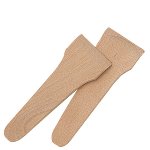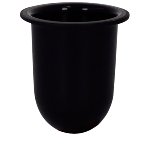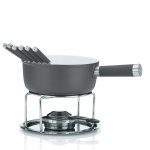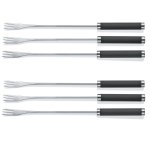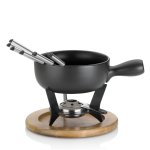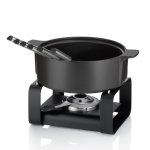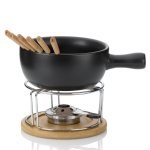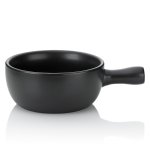- Bath
- Kitchen
- Collections
- Contact
- Company
- Catalogues

Cheese fondue set & recipes
Everything about cheese fondue: premium sets for traditional Swiss cheese fondue or vegan alternatives.
Cheese fondue - the guaranteed delight for a delicious and cosy meal
Have you ever tried cheese fondue? Maybe at a restaurant, with friends, or is it a regular treat in your home? Thinking about cheese fondue immediately conjures up images of warmth and comfort. It’s especially popular during the winter, particularly at Christmas and New Year’s Eve. Yet, it’s equally enjoyable on those first chilly autumn days when dipping fresh bread into melted cheese feels like the ultimate indulgence. Ready to plan a cheese fondue evening at home? With the Natura Cheese Fondue Set and the separately available fuel paste, you’re all set to dive into the cosy experience with family or friends.
The main ingredients of cheese fondue are: cheese, wine and bread. Whether with or without schnapps, light or hearty bread, or specific side dishes, it all comes down to personal taste. For those who enjoy adding decorative flair, the cosy atmosphere can be enhanced with felt placemats, matching napkins, side dish bowls, and bread baskets.
Can you already smell the warm, melted cheese?
Cheese fondue sets by kela
To enjoy an authentic cheese fondue experience, investing in a proper cheese fondue set is key. These sets include everything you need: the caquelon (pot) made of ceramic or cast aluminium, a matching rechaud with a burner, and fondue forks. Don’t forget the fuel paste to get started right away and enjoy a seamless fondue experience.
Traditionally, cheese fondue is prepared in a ceramic pot designed specifically for the purpose. Alongside these classic ceramic pots, our range also features cast aluminium fondue pots with a ceramic coating. The coating prevents the cheese mixture from burning, and the aluminium pot is induction-compatible.
Our cheese fondue sets are similar in structure and capacity, but they differ in colour and design. Options range from light ceramic sets with stag decorations to elegant sets with stylish rechauds and black ceramic fondue pans. The Country Fondue Set combines elegance with a natural aesthetic. Take a look in our shop.

Cheese fondue pots or pans
Pot, pan, caquelon… Is there a difference between these utensils for cheese fondue? These terms are used interchangeably. The distinctive shape with a side handle might explain the term "pan." The caquelon specifically refers to a cheese fondue pot, typically made of ceramic. Regardless of the term used, they all describe the same thing. What’s most important is that the cheese fondue pot distributes heat slowly and evenly, ensuring the cheese melts consistently without burning at the bottom. This is why ceramic fondue pots often have a thicker base.
Metal pots, which heat up quickly, are not suitable for cheese fondue as the cheese is likely to stick and burn at the bottom.

Is a cheese fondue pot suitable for induction?
A classic ceramic cheese fondue pot is not suitable for induction. Induction-suitable pots are a prerequisite for an induction hob. All pots with a ferromagnetic base are suitable for induction, i.e. typically pots made of cast iron and stainless steel. This is why there are already many models made of cast aluminium or cast iron that are suitable for both induction hobs and the rechaud. The Lancy cheese fondue set and the Meyrin cheese fondue pan made of cast aluminium with a ceramic coating are perfect for an induction stove.
If you have an induction hob in your kitchen, you should opt for an induction-suitable cheese fondue pan. Although it is possible to melt the cheese in a suitable pot on the hob and then transfer it to a cheese fondue pan, this process consumes more resources and is somewhat more cumbersome than a suitable pot for induction.
Swiss cheese fondue - origins and ingredients
The origin of cheese fondue is often attributed to the Western Alps. It is probably the case that Swiss cheese fondue became an important part of the culture in the Western Alps in the 1950s, but cheese fondue is historically mentioned in publications as early as the 17th and 18th century. Even today, in the Western Alps and in many other regions in Switzerland and France, you can still find traditional cheese fondues being served, or fondue au fromage, as it is called in France. However, not all cheese fondues are the same. Even within Switzerland, there are many regional variations.
The following main ingredients are used for traditional cheese fondue: cheese, white wine, a little cherry brandy, bread, salads, sweet and sour sides, pepper, nutmeg and more white wine.

What cheese to use for fondue?
Classic cheese fondue features a mix of Gruyère, Vacherin, Swiss Emmental, and Appenzeller. The proportions depend on personal preference. For a milder taste, use more Emmental; for a stronger flavour, add extra Appenzeller. Plan for approximately 180–220 grams of cheese per person.
Generally, any hard cheese can be used for fondue, as it should be grated before melting. Soft cheeses like goat cheese, feta, or blue cheese also work well, as they can be cut into small pieces before melting.
Ready to indulge in the perfect cheese fondue evening? Explore our range of cheese fondue sets and bring warmth and flavour to your table!

Cheese fondue side dishes - a must-have
Salads are the perfect accompaniment to a cheese fondue. They provide a nice balance to the fatty cheese. Leaf salads such as romaine, oak leaf or radicchio are ideal, as these salads are a little stronger and stay fresh and firm to the bite for longer in the dressing. However, lamb's lettuce should always be served. This salad not only boasts an intense flavour, but also contains lots of nutrients. One thing is certain: the salad is popular with almost everyone, regardless of whether it is called lamb's lettuce, lamb's lettuce, field salad, mouse ear salad or rapunzel.
Pickled vegetables and fruit are other side dishes that harmonise perfectly with a delicious cheese fondue. Cornichons, silver onions, olives, small corn on the cob, caper apples and small jacket potatoes can be served in small bowls. Grapes, sliced pears, pineapple and ripe figs are ideal for in-between meals and for fruit lovers.
It is nice if guests are offered different types of bread. The selection can range from light-coloured white bread, baguettes and rustic bread from the stone oven to tempting varieties baked with strong spices such as fennel and caraway seeds or beer. The bread is coarsely diced so that it is the perfect size for dipping. The bread can also be offered to guests in slices. Arrange the bread in small bowls and place them on the table for everyone to grab.
Cheese fondue recipe - Make your own cheese fondue
Ingredients (for 6 people)
- 400 g Le Gruyère AOP
- 300 g Vacherin Fribourgeois AOP
- 300 g Appenzeller (matured for 3 or 6 months)
- 200 g Emmentaler AOP
- 1 clove of garlic, halved lengthways
- 5 tsp cornflour
- 1 tbsp lemon juice
- Grated nutmeg, pepper, possibly salt, paprika powder
- 600 ml dry white wine
- possibly 4 tbsp kirsch
- 1 kg bread: baguette, various farmhouse breads
Preparation
1 Remove the cheese rinds and coarsely grate it. Cut the bread into bite-sized pieces.
2 Rub the bottom of the pan with the garlic clove cut lengthways.
3 Now pour the wine and lemon juice into the pan and heat over medium heat. As soon as the liquid starts to boil/simmer, reduce the heat.
4 Gradually melt the cheese in the liquid, stirring constantly to ensure it melts evenly.
5 Mix the cornstarch with a portion of the kirsch and add it to the cheese mixture. Pour in the remaining kirsch and briefly bring the mixture to a boil.
6 Season to taste with nutmeg, pepper, paprika and/or salt.
7 Light the fuel paste in the rechaud and transfer the cheese mixture into the fondue pot. Place the pot on the rechaud to keep it warm.
8 Now add bread, vegetables or fruit round by round and stir into the cheese mixture. This keeps the cheese fondue creamy.
At the same time, arrange the bread and other ingredients in baskets and small bowls and place them on the table.
The label "AOP" (Appellation d'Origine Protégée), meaning "Protected Designation of Origin," is a mark of quality. It guarantees that the milk comes from the same region where the cheese is produced and aged. These cheeses are artisanal products of the highest quality.
If children are eating with you, the wine can be replaced by the same amount of apple or grape juice. Alcohol-free wines are also available in stores.
Vegan cheese fondue
Although it may not sound quite right at first, there are extremely tasty recipes for vegan cheese fondues. These recipe alternatives, mostly based on potatoes and cashews, certainly differ in flavour from a classic cheese fondue, but they are no less delicious. And the communal get-together and stirring of bread, vegetables and fruit in the cheese fondue pot remains the same.
Cheese fondue accessories - plates, bowls, table linen
The icing on the cake for a perfect cheese fondue evening can be complementary table linen and/or matching serving dishes. You can also find ideas in our cheese fondue inspiration.
Typical fondue plates with dividers offer plenty of space to arrange the delicious side dishes on the plate. The Anneli round fondue plate, like the Vroni oval fondue plate offers space in five compartments. These fondue plates are also perfect for a meat or vegetable fondue in fat or broth.
Care and use instructions for the cheese fondue utensils
Ceramic cheese fondue pan
- To avoid hairline cracks, place the pan in cold, clear water for two hours before use and then leave it to dry for approx. 2 hours
- Do not scratch the pan with pointed or sharp-edged objects
- No washing-up liquid or steel wool should be used for cleaning
- Suitable for all hob types, except induction
Cast aluminium cheese fondue pan
- Clean with hot water and a mild washing-up liquid before use
- Do not scratch the pan with pointed or sharp-edged objects
- Please do not use steel wool for cleaning
- suitable for induction
Frequently asked questions about cheese fondue
How do you make cheese fondue?
Special ceramic or cast aluminium pots that release heat slowly and constantly are suitable for a cheese fondue. This ensures that the cheese melts evenly and does not burn. The grated cheese is first melted in white wine in the pot on the cooker, thickened with starch and flavoured with spices. As soon as the cheese has melted, the cheese fondue pot is placed on the appropriate rechaud on the table.
Which wine goes best with cheese fondue?
Light and dry white wines harmonise best with cheese fondue. Primarily Swiss wines, such as Fendant, but Pinot Gris, Sauvignon Blanc or Riesling also go perfectly. If you prefer red wine to white wine, a fruity Pinot Noir, Beaujolais or Dôle is a good choice.
How much cheese do you need per person for a cheese fondue?
It is always difficult to determine the right amount of cheese for a cheese fondue or raclette. The guideline is 200 - 250 g of cheese per person. However, this amount is very individual. What is served with the cheese fondue? Are children included? If an appetiser is served beforehand or a dessert afterwards, this can also reduce the amount of cheese.
How do I clean a cheese fondue pot?
The best way is simply with water. Soak the cheese fondue pot in cold water. Initially for 1-2 hours, if necessary the pot can also be soaked overnight. The cheese residue can then be easily removed with a dough scraper so that the cheese does not stick to the cloth or brush.
Why do ceramic pans have fine hairline cracks? Can I use them without hesitation?
Hairline cracks in the glaze can occur due to the high temperature fluctuations caused by use, which in no way impair the functionality or reduce the quality of the cheese fondue pan. To avoid hairline cracks, the pan can be placed in cold, clear water for two hours before use and then left to dry for around two hours.





